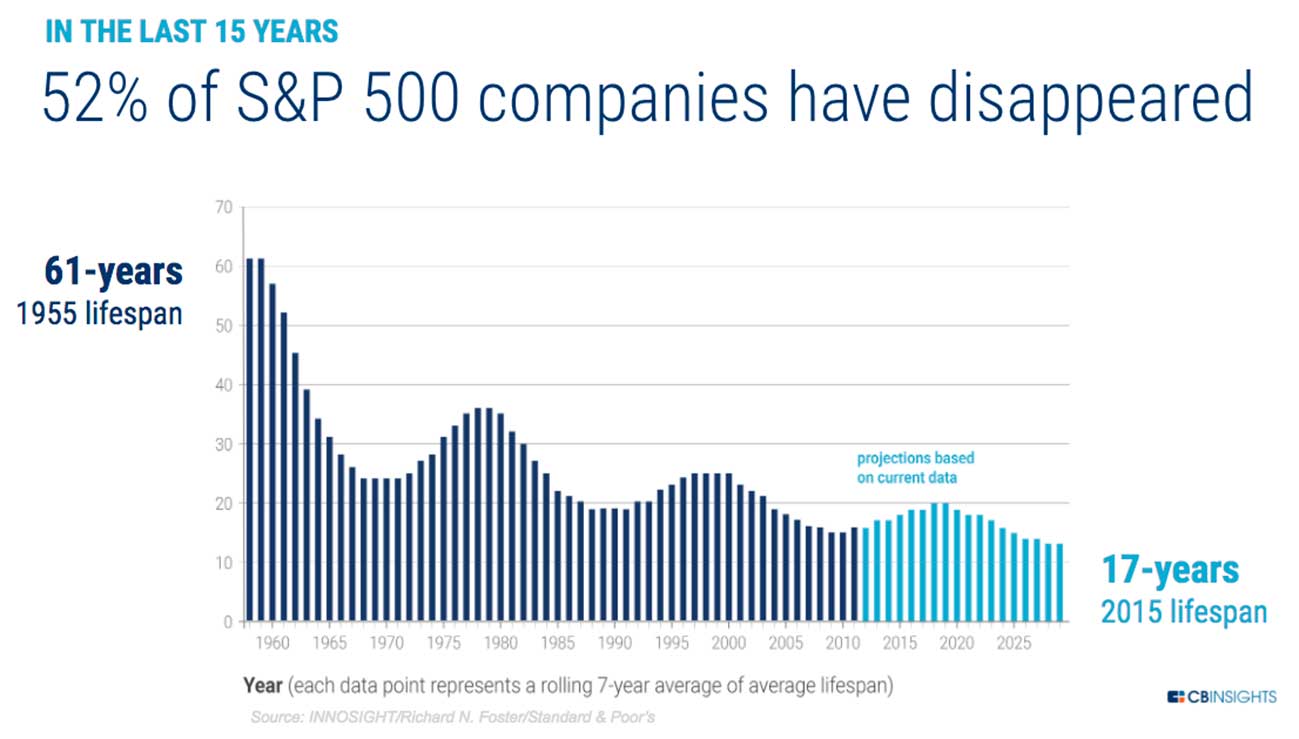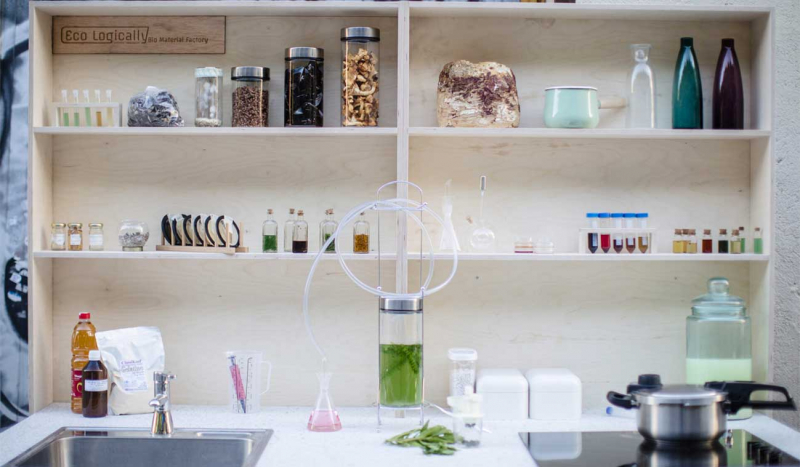Culture
The two ingredients of innovation
Today more and more companies, large and small, are combining Technology and Sustainability for transforming times of difficulty or threats into opportunities for growth.
Jul 2020
Andy Grove, the legendary CEO of Intel Corporation, once said that bad companies are destroyed by crises, good companies survive them, but great companies are improved by them. And it’s true. History teaches us that companies which see change as an opportunity to evolve and grow. Those that keep doing the same old things in the same old way are highly likely to be out of the market sooner or later.
Just consider that in the last twenty years, 52% of the S&P 500 (the 500 US companies with the largest capitalization) have shut down. Some of these were businesses that had existed for almost a century, but failed to cope with the technological, social and cultural revolution that marked the start of the third millennium. They stopped innovating and gave way to new companies. Netflix gained the market shares lost by Blockbuster; iTunes gained those lost by the record industry; the digital camera replaced the analogue one, and so on.
Technological innovation has often played a fundamental role in this transformation. And this is shown by the fact that in 2001, the five companies with the highest market value were General Electric with a valuation of 406 billion, Microsoft with 365 billion, Exxon with 272 billion, Citi with 261 billion and Walmart with 260 billion. So, energy, oil, finance, large retailers – but only 20% technology. Just fifteen years later, in 2016, the scenario had changed completely and the five companies with the largest capitalization all belonged to the technology sector: Apple in first place with 582 billion, followed by Alphabet (or rather Google) with 556 billion, then Microsoft with 452 billion, Amazon with 364 billion and finally Facebook with 359 billion. These are companies that continue to grow and evolve, increasing their value (some have exceeded 1,000 billion) and revolutionizing the sectors they operate in.
Digital, and more generally technology, is a key tool in a company's innovation process. Once upon a time, rethinking your business model from a digital perspective was a possibility. Today, it is increasingly a necessity. Whatever the size of our company or the sector we operate in, today we have to be digital. Or at least also digital. Technology can help us to reduce production costs, in some cases bringing us closer to zero marginal cost. It can help us innovate our service, improve our Customer Relationship Management and optimize our processes. And this helps us to be more streamlined, flexible and dynamic.
However, there is another ingredient, apart from technology, which allows companies to innovate their business model and enhance their competitive advantage: sustainability. That is, making a profit, but doing so by generating a positive impact on society and the environment. Asking ourselves how our business could improve the world and the lives of the people who inhabit it.
And this is a question all entrepreneurs should ask themselves, not only from an “ethical” but also strategic point of view. Because moments of difficulty and change are an excellent opportunity to review our business model and reduce inefficiencies, with a view to sustainability, both economic and environmental.
To better understand the importance of this strategy, just consider the success of companies like TOMS shoes, which developed the One for One® business model: for every pair of shoes you buy, TOMS will help someone in difficulty. This is a model that has enabled the company to have a positive impact on society on the one hand, and on the other gain great media visibility and thereby increase sales.
Or consider the French start-up BLABLACAR which has built a platform for sharing space in cars, thus reducing both car emissions (environmental sustainability) and the company's fixed costs (economic sustainability). In fact, unlike any other company offering a long-distance transport service, BLABLACAR does not own any vehicles and therefore has much lower fixed costs. And this has enabled it, in under ten years, to become the European leader in ride sharing services for long journeys, so much so that Guillaume Pepy, president of La Société Nationale des Chemins de fer Français has identified BlaBlaCar as one of its main competitors.
By combining innovation and sustainability, both TOMS and BLABLACAR have therefore managed to:
• Expand their customer bases
• Reduce marketing and communication costs
• Limit (or even eliminate as in BlaBlaCar's case) certain fixed costs
• Enter saturated markets with high entry barriers
• Innovate their business model
• Increase their appeal for investors and the market.
In 2012, Adidas, the largest sportswear manufacturer in Europe and the second largest in the world, began a campaign against plastic waste that led the German company to rethink its production process and launch innovative products and campaigns on the market. Like the End Plastic Waste project, or the Parley collection, made using plastic waste collected from beaches. And they are not the only ones. Today more and more companies, large and small, are combining innovation and sustainability for transforming times of difficulty or threats into opportunities for growth.
In 2017, the French food company Danone, which sells its products in 120 countries and has a turnover of over 25 billion dollars, began a journey that led to Danone North America and Danone Canada becoming the largest Certified B Corporation companies in the world. Certifying your company as a B Corporation means positioning it on the market as an innovative business in terms of both production processes and sustainability. And this allows it to differentiate itself from competitors and strengthen its competitive advantage.
Always attentive to sustainability, in recent years Ikea has also launched many initiatives combining technology and sustainability in order to strengthen its positioning and innovate its business model. In response to the global problem of plastic waste, the Swedish company launched the KUNGSBACKA line of kitchen doors, made of recycled wood and covered with a plastic film obtained from recycled PET bottles, in order to reduce waste and give new life to plastic waste. And many of the products and initiatives conceived and launched by Space10, Ikea's innovation lab, are also moving in this direction: combining innovation and sustainability.
Also of great interest is the carbon-offset shipping initiative, promoted by the online shopping platform Etsy, which aims to offset 100% of the carbon emissions generated by shipping. At no additional cost to buyers or sellers, every time a purchase is made from one of the e-commerce sites on the platform, Etsy finances verified emission reduction projects through its partner 3Degrees.
All these initiatives not only contribute to improving the world, but enable companies that promote them to differentiate, innovate and grow by increasing their offer of products or services
Based on the same principle, the Compensaid service was created by Lufthansa. It allows individuals and companies to offset the CO2 produced by our travels and in particular by flights, which currently represent one of the sources of CO2 emissions (2% of all human induced CO2 emissions and 12% from all transports sources, compared to 74% from road transport, ATAG). All these initiatives not only contribute to improving the world, but enable companies that promote them to differentiate, innovate and grow by increasing their offer of products or services, as well as their Brand Awareness.
It is a model that works. And we say this from experience. Every day we too, at Treedom, combine technological innovation and environmental sustainability to create a better future for our company, for the people who work there and for the planet. Technology allows us to improve our service and offer our customers and partners innovative and cutting-edge solutions. But it is sustainability that motivates us, allows us to inject passion and enthusiasm into everything we do and, above all, gives meaning to our work.
But what is needed to rethink our business model with a view to sustainability that is economic as well as environmental? There is no universal formula, but based on the cases men7oned, we can list five essential elements for dealing with this transformation.
01. A valid reason. Why do we want to innovate our business model? What are our long and short-term goals? What real problem can we solve? And how can our business have a positive impact on the world and the people who live in it?
02. A new mentality. Einstein said that “problems cannot be solved using the same mentality that created them”. And he was right. To deal with a process of transformation, we need to change our mentality starting with the market and not the product – by trying to escape a business logic to think like our public.
03. More streamlined processes. Changing means experimenting. And to experiment, we need more streamlined, flexible and dynamic business processes. We need to conduct market tests, collect data and feedback from our customers, and adjust our product or service based on the information collected. Before embarking on a process of transformation, it is advisable to review our structure, reduce fixed costs where possible and focus our offer.
04. Motivated people. Change begins and ends with people. Within the company, the motivation behind the change of direction must be clear and shared with everyone involved in the process of producing the company's value. From suppliers to employees.
05. A differentiating factor. What makes our company unique? What is the essence of our business? Why do customers choose our products or services over someone else's? It may be for our business model, as in the case of TOMS, or it may be for sustainability, but if we want to guarantee our company a competitive advantage in the long term we must differentiate ourselves: we must aim to be unique, not the best.
The original version of this story is by J. Perfetti edited for Treedom.







